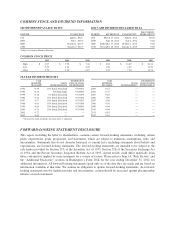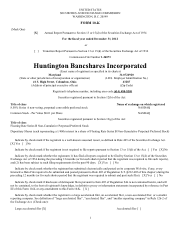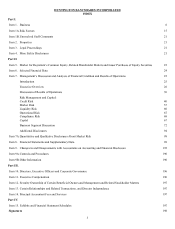Huntington National Bank 2012 Annual Report Download - page 17
Download and view the complete annual report
Please find page 17 of the 2012 Huntington National Bank annual report below. You can navigate through the pages in the report by either clicking on the pages listed below, or by using the keyword search tool below to find specific information within the annual report.
9
Regulatory Matters
We are subject to regulation by the SEC, the Federal Reserve, the OCC, the CFPB, and other federal and state regulators.
Because we are a public company, we are subject to regulation by the SEC. The SEC has established five categories of issuers for
the purpose of filing periodic and annual reports. Under these regulations, we are considered to be a large accelerated filer and, as
such, must comply with SEC accelerated reporting requirements.
We are a bank holding company and are qualified as a financial holding company with the Federal Reserve. We are subject to
examination and supervision by the Federal Reserve pursuant to the Bank Holding Company Act. We are required to file reports and
other information regarding our business operations and the business operations of our subsidiaries with the Federal Reserve.
The Federal Reserve maintains a bank holding company rating system that emphasizes risk management, introduces a framework
for analyzing and rating financial factors, and provides a framework for assessing and rating the potential impact of non-depository
entities of a holding company on its subsidiary depository institution(s). A composite rating is assigned based on the foregoing three
components, but a fourth component is also rated, reflecting generally the assessment of depository institution subsidiaries by their
principal regulators. The bank holding company rating system, which became effective in 2005, applies to us. The composite ratings
assigned to us, like those assigned to other financial institutions, are confidential and may not be disclosed, except to the extent
required by law.
On December 17, 2012, the Federal Reserve issued Supervisory Letter SR 12-17, which sets forth an updated framework for the
consolidated supervision of large financial institutions, including bank holding companies with consolidated assets of $50 billion or
more. The objectives of the new framework are to enhance the resilience of a firm, lower the probability of its failure, and reduce the
impact on the financial system in the event of an institution’s failure. With regard to resiliency, each firm is expected to ensure that the
consolidated organization and its core business lines can survive under a broad range of internal or external stresses. This requires
financial resilience by maintaining sufficient capital and liquidity, and operational resilience by maintaining effective corporate
governance, risk management, and recovery planning. With respect to lowering the probability of failure, each firm is expected to
ensure the sustainability of its critical operations and banking offices under a broad range of internal or external stresses. This
requires, among other things, effective resolution planning that addresses the complexity and the interconnectivity of the firm’s
operations.
The Bank, which is chartered by the OCC, is a national bank, and our only bank subsidiary. It is subject to examination and
supervision by the OCC and by the CFPB established by the Dodd-Frank Act. Our nonbank subsidiaries are also subject to
examination and supervision by the Federal Reserve or, in the case of nonbank subsidiaries of the Bank, by the OCC. Our subsidiaries
are subject to examination by other federal and state agencies, including, in the case of certain securities and investment management
activities, regulation by the SEC and the Financial Industry Regulatory Authority.
The Bank is subject to affiliate transaction restrictions under federal law, which limit certain transactions generally involving the
transfer of funds by a subsidiary bank or its subsidiaries to its parent corporation or any nonbank subsidiary of its parent corporation,
whether in the form of loans, extensions of credit, investments, or asset purchases, or otherwise undertaking certain obligations on
behalf of such affiliates. Furthermore, covered transactions which are loans and extensions of credit must be secured within specified
amounts. In addition, all covered transactions and other affiliate transactions must be conducted on a market terms basis and under
circumstances that are substantially the same as such transactions with unaffiliated entities.
Legislative and regulatory reforms continue to have significant impacts throughout the financial services industry.
The Dodd-Frank Act, which is complex and broad in scope, established the CFPB, which has extensive regulatory and
enforcement powers over consumer financial products and services, and the Financial Stability Oversight Council, which has
oversight authority for monitoring and regulating systemic risk. In addition, the Dodd-Frank Act alters the authority and duties of the
federal banking and securities regulatory agencies, implements certain corporate governance requirements for all public companies
including financial institutions with regard to executive compensation, proxy access by shareholders, and certain whistleblower
provisions, and restricts certain proprietary trading and hedge fund and private equity activities of banks and their affiliates. The
Dodd-Frank Act also requires the issuance of many implementing regulations which will take effect over several years, making it
difficult to anticipate the overall impact to us, our customers, or the financial industry in general.
With the appointment of a director for the CFPB in January 2012, the CFPB began to exercise its full authority under the Dodd-
Frank Act. For example, the CFPB completed its first public enforcement actions regarding unfair, deceptive or abusive practices in
connection with marketing, sales and operation of certain add-on products offered in connection with credit cards. Furthermore, in
2012 the CFPB issued its first major regulation, which covers remittance transfers (international wire transfers) by consumers, which
will take effect later in 2013.
























